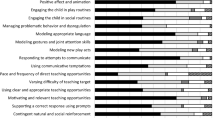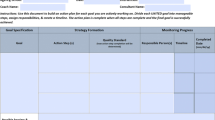Abstract
Autism researchers have identified a set of common effective practice elements for early intervention (EI) (e.g., intensive programming). The current study examined the reported use of common elements of effective interventions in community EI settings. Eighty EI providers reported about their programs. The majority of participants reported using common effective elements, however, the depth and quality of the use of these elements was highly variable. Taking community program structure into account in future research will facilitate the development of methodologies, which immediately fit into the context of community programming rather than requiring program adaptation for use in the real world. Recommendations for using current community program structure to improve use of evidence-based practices are discussed.

Similar content being viewed by others
Notes
Based on July 1, 2004 estimated population by US Census Bureau.
References
Bondy, E., & Brownell, M. T. (2004). Getting beyond the research to practice gap: Researching against the grain. Teacher Education and Special Education, 27, 47–56.
Cochran-Smith, M., & Lytle, S. (1999). Relationships of knowledge and practice: Teacher learning in communities. In A. Iran-Nejar & P. D. Pearson (Eds.), Review of research in education (pp. 249–305). Washington, DC: American Educational Research Association.
Dawson, G., & Osterling, J. (1997). Early intervention in autism: Effectiveness, common elements of current approaches. In M. J. Guralnick (Ed.), The effectiveness of early intervention: Second generation research (pp. 307–326). Baltimore: Paul H. Brookes.
Dunlap, G. (1999). Consensus, engagement, and family involvement for young children with autism. Journal of the Association for Persons With Severe Handicaps, 24, 222–225.
Greenspan, S. I., & Wieder, S. (1997). Developmental patterns and outcomes in infants and children with disorders in relating and communicating: A chart review of 200 cases of children with autistic spectrum diagnoses. Journal of Developmental and Learning Disorders, 1, 87–141.
Gresham, F. M., Beebe-Frankenberger, M. E., & MacMillan, D. L. (1999). A selective review of treatments for children with autism: Description and methodological considerations. School Psychology Review, 28, 559–575.
Howlin, P. (1998). Practitioner review: Psychological and educational treatments for autism. Journal of Child Psychology and Psychiatry, 39, 307–322.
Hurth, J., Shaw, E., Izeman, S. G., Whaley, K., & Rogers, S. J. (1999). Areas of agreement about effective practices among programs serving young children with autism spectrum disorders. Infants and Young Children, 12, 17–26.
Iovannone, R., Dunlap, G., Huber, H., & Kincaid, D. (2003). Effective educational practices for students with autism spectrum disorders. Focus on Autism and Other Developmental Disabilities, 18, 150–165.
Jacobson, J. W., & Mulick, J. A. (2000). System and cost research issues in treatments for people with autistic disorders. Journal of Autism and Developmental Disorders, 30, 585–593.
Lovaas, O. I. (1987). Behavioral treatment and normal educational and intellectual functioning in young autistic children. Journal of Consulting and Clinical Psychology, 55, 3–9.
Lovaas, O. I., Koegel, R., Simmons, J. Q., & Long, J. S. (1973). Some generalization and follow-up measures on autistic children in behavior therapy. Journal of Applied Behavior Analysis, 6, 131–166.
Mandlawitz, M. R. (2002). The impact of the legal system on educational programming for young children with autism spectrum disorder. Journal of Autism and Developmental Disorders, 32, 495–508.
Mcgee, G. G., Morrier, M. J., & Daly, T. (1999). An incidental teaching approach to early intervention for toddlers with autism. Journal of the Association for Persons with Severe Handicaps, 24, 133–146.
National Research Council (2001). Educating children with autism. Washington, DC: National Academy Press.
Ollendick, T. H., & Hersen, M. (1993). Child and adolescent behavioral assessment. Handbook of child and adolescent assessment. General psychology series (Vol. 167, pp. 3–14). Needham Heights, MA: Allyn & Bacon.
Ozonoff, S., Rogers, S. J., & Hendren, R. L. (2003). Autism spectrum disorders: A research review for practitioners. Washington, DC: American Psychiatric Publishing Inc.
Robbins, F. R., Giordano, S., Rhoads, S., & Feldman, R. S. (1996). Preschool children with autism: Current conceptualizations and best practices. In R. S. Feldman (Ed.), The psychology of adversity (pp. 63–90). Amherst, MA: University of Massachusetts Press.
Rogers, S. J. (1996). Early intervention in autism. Journal of Autism and Developmental Disorders, 26, 243–246.
Rogers, S. J. (1998). Empirically supported comprehensive treatments for young children with autism. Journal Clinical Child Psychology, 27, 168–179.
Schreibman, L., & Koegel, R. L. (2005). Training for parents of children with autism: Pivotal responses, generalization, and individualization of interventions. In E. D. Hibbs & P. S. Jensen (Eds.), Psychosocial treatments for child and adolescent disorders: Empirically based strategies for clinical practice (2nd ed., pp. 605–631). Washington, DC: American Psychological Association.
Stahmer, A. C., Collings, N. M., & Palinkas, L. A. (2005). Early intervention practices for children with autism: Descriptions from community providers. Focus on Autism and Other Developmental Disabilities, 20, 66–79.
Strain, P., & Cordisco, L. (1994). LEAP Preschool. In S. L. Harris & J. S. Handleman (Eds.), Preschool education programs for children with autism (pp. 225–244). Austin, TX: PRO-ED.
Strain, P., McGee, G., & Kohler F. W. (2001). Inclusion of children with autism in early intervention settings: An examination of rationale, myths, and procedures. Early childhood inclusion: Focus on change. Baltimore, MD: Paul H. Brooks.
Thomas, K., Morrissey, J., & McLaurin, C. (2004). A look at autism service use across North Carolina. Paper presented in symposium: A services research perspective on autism. American Public Health Association 132nd Annual Meeting, Washington, DC.
Tsai, L. Y. (1998). Pervasive developmental disorders briefing paper. Washington, DC: NICHCY.
Weisz, J. R., Chu, B. C., & Polo, A. J. (2004). Treatment dissemination and evidence-based practice: Strengthening intervention through clinician-researcher collaboration. Clinical Psychology: Science and Practice, 11(3), 300–307.
Acknowledgments
This research was supported by a Child and Adolescent Services Research Grant number K01 MH65325–01 from the National Institute of Mental Health. The author would like to thank Nicole Collings, Dorothy Borszack-Vega, and Rachel Enkey for their assistance with the interview development, interview implementation, and data entry and analyses; Laura Schreibman, Mark Appelbaum, Andrew Bondy, Michelle Sullivan, the students and UCSD Autism Laboratory, the staff at Children’s Toddler School for assistance with question development, modification, and piloting the interview; and the journal editors for their insightful suggestions. Finally, the author thanks the service providers for taking time out of their busy schedules to provide valuable insight and information to the field through participation in this research.
Author information
Authors and Affiliations
Corresponding author
Rights and permissions
About this article
Cite this article
Stahmer, A.C. The Basic Structure of Community Early Intervention Programs for Children with Autism: Provider Descriptions. J Autism Dev Disord 37, 1344–1354 (2007). https://doi.org/10.1007/s10803-006-0284-x
Received:
Accepted:
Published:
Issue Date:
DOI: https://doi.org/10.1007/s10803-006-0284-x




